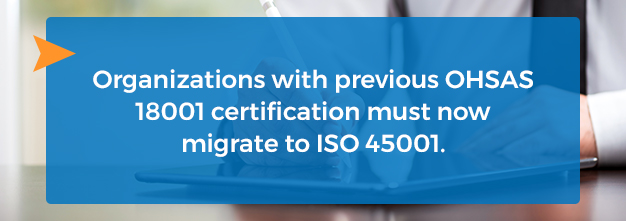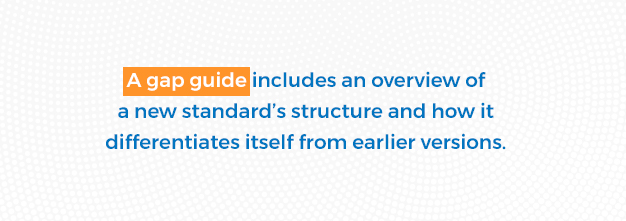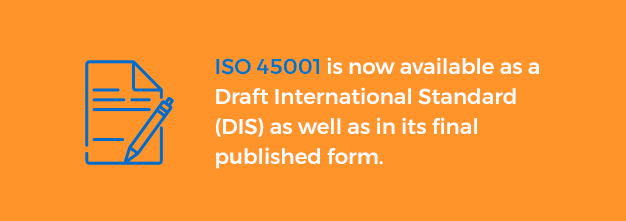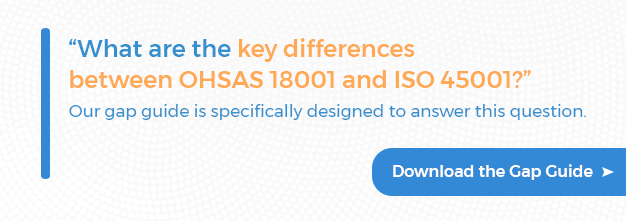OHSAS 18001 to ISO 45001 Gap Guide
First published in 1999, OHSAS 18001 has long been recognized as the occupational health and safety — or OH&S — management standard that organizations can use to assess their health and safety systems. Now, nearly 20 years later, the new ISO 45001 standard has been published to help today’s organizations achieve even better OH&S practices.

Since its final version that was released in March 2018, ISO 45001 has superseded OHSAS 18001. Organizations with previous OHSAS 18001 certification must now migrate to ISO 45001 within a specified timeline in order to remain certified.
At National Quality Assurance, we’ve leveraged our experience as one of the world’s most noted ISO registrars and put together a highly informative gap guide to help businesses accomplish this migration in a timely and successful manner.
What Is A Gap Guide?
Despite many identical and similar requirements between OHSAS 18001 and ISO 45001, there are differences, additions and sequential changes. Clearly, any company that needs to migrate to the new ISO system should conduct a thorough gap analysis in preparation for the switch. A gap guide serves as a much-needed document to quickly recognize the key changes the new system introduces.
In general, a gap guide includes an overview of a new standard’s structure and how it differentiates itself from earlier versions. It also includes an in-depth, clause-by-clause comparison between the two most recent versions, a new terminology section, notes specifically on compliance issues and — if applicable — a transition timeline.
In the specific instance of ISO 45001, our gap guide is based on the Draft International Standard (DIS) and provides an overview of the key changes between the OHSAS BS 18001:2007 and the 2016 version of ISO 45001, which puts forward new requirements. It is possible that some requirements may be amended between the DIS, FDIS and ISO standard. Of course, any amendments will be reflected in future issues of our guide.
If you have an OHSAS 18001 compliant Occupational Health & Safety Management System (OHSMS), you will need to prepare for change and adapt your management system to meet the new requirements within the transitional timelines.
Download Our Gap Guide For A Clause-By-Clause Comparison
Contents Of The Gap Guide
One of our goals is to translate the language of standards, systems and certification to help you plan, implement and optimize your management systems. Our gap guide can help you do just that. To further simplify the process, its contents contain the following sections:- ISO 45001:2016 Timeline. To ensure you meet the new requirements within the transitional timeline.
- Structure of ISO 45001:2016. Aligned to Annex SL, the common structure of ISO management systems standards, including ISO 9001:2015 and ISO 14001:2015.
- Clause-by-clause comparison of ISO/DIS 45001:2016 vs. OHSAS 18001:2007. You will see what has changed and what is new so you can plan ahead.
- Guidance notes for compliance with new requirements. New requirements are a priority for ensuring compliance – these are clearly highlighted for your attention.
- Key terminology. ISO 45001 introduces some new terminology which is summarized at the end of the guide.
Download The Gap Guide Now
What Is ISO 45001?
ISO 45001, the successor to OHSAS 18001, is now available as a Draft International Standard (DIS) — as well as in its final published form. Its intention is to help organizations better integrate their approach to their workers’ well-being and safety through its current OH&S management system.
Organizations adopting an ISO 45001 certified system of OH&S management can expect to increase their awareness of health and safety risks. They’ll also improve their ability to react to avoid these risks and enhance the engagement of workers when it comes to actively participating in improving workplace safety.
Additionally, while some organizations may follow ISO 45001 voluntarily, for many others, it’s a legal requirement they must meet to conduct business in a safe and compliant manner.
Key Changes Between OHSAS 18001 And ISO 45001
At NQA, we often hear the question, “What are the key differences between OHSAS 18001 and ISO 45001?” It’s a fair question that our gap guide is specifically designed to answer.Both standards are concerned with improving safety and health initiatives. However, while OHSAS outlines a more delegated and reactive method of controlling hazards, ISO 45001 is structured around greater engagement and a proactive approach to risk mitigation. This fundamental difference means that organizations adopting ISO 45001 need to demonstrate a commitment to OH&S management, which involves the C-suite taking an active role in leading enterprise-wide safety measures and practices.
With regard to terminology, in OHSAS 18001, hazard controls were put in place to avoid a reoccurrence of an accident. In ISO 45001, due to a new focus on risk reduction, these measures are more aptly described as hazard risks that need to be addressed in order to prevent accidents from occurring in the first place.
From a nuts and bolts perspective, ISO 45001 is structured according to Annex SL — the same framework employed by other ISO management systems — to make its implementation less complex and cumbersome.

For more information about ISO 45001, we have a range of materials available:
- Read our guide to ISO 45001
- Download your ISO 45001 briefing document
- Watch the ISO 45001 migration video featuring Terry Fisher
- Get your copy of the OHSAS 18001 to ISO 45001 transition timeline
Sign Up To Receive Essential ISO 45001 Updates
By signing up, you will also receive our monthly newsletter InTouch, which provides legal updates and practical management systems guidance.
If you have any questions about ISO 45001, please contact us on 0800 052 2424 or contact us.
